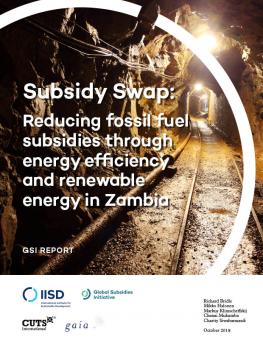
Subsidy Swap: Reducing fossil fuel subsidies through energy efficiency and renewable energy in Zambia
This report examines the potential of subsidy reform to improve cost recovery in the electricity sector and promote clean energy and energy efficiency in Zambia.
In Zambia’s electricity sector, demand has risen faster than supply.
In response to rising demand, several new power plants have been commissioned, including the 300 MW Maamba coal power plant and the 120 MW Itezhi Tezhi hydropower plant in 2016. Subsidies, particularly in the form of under-recovery of electricity sector revenues caused by below-cost pricing, have led to electricity sector deficits and threatened the financial sustainability of the sector.
Price increases in the electricity sector in 2017 of 75 per cent have reduced electricity sector subsidies, but costs remain higher than revenues. This report explores how subsidy reform could help to reduce the cost of subsidies and promote a transition to energy efficiency and clean energy. The report focuses on the mining sector, which is responsible for more than half of all electricity consumption, and the potential of solar PV.
Participating experts
You might also be interested in
G20 Finance Ministerials and World Bank/IMF Spring Meetings: Expert comment
G20 finance ministerials and World Bank/IMF spring meetings will take place this week in Washington. High on the agenda is the need to mobilize trillions of dollars of investment in the transition to clean energy.
South African Fossil Fuel Subsidies Hit Record Highs as Country's Energy Crisis Deepens
South Africa's fossil fuel subsidies tripled between 2018 and 2023, hitting USD 7.5 billion, up from USD 2.9 billion 5 years earlier, a new report by IISD reveals.
Blackouts and Backsliding: Energy subsidies in South Africa 2023
Blackouts and Backsliding presents the latest energy subsidy data for South Africa.
Copenhagen Climate Ministerial: Expert comment
Around 40 climate leaders and ministers are meeting in Copenhagen from March 21 to 22 to discuss priorities for COP 29.